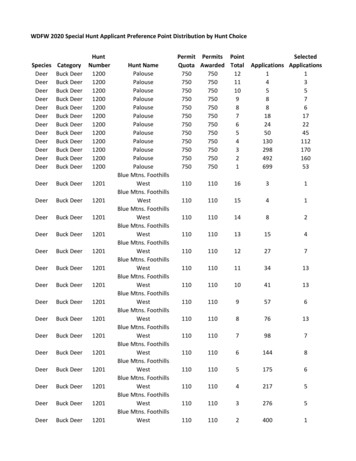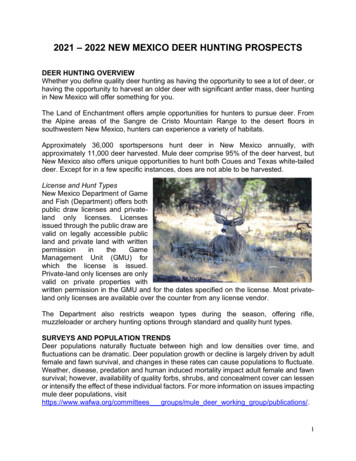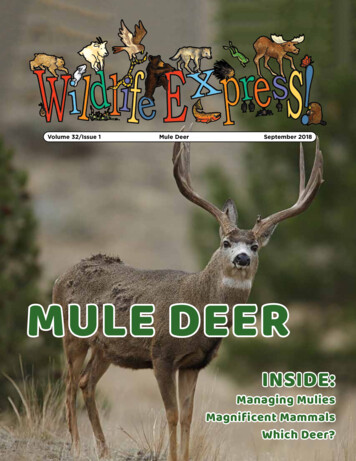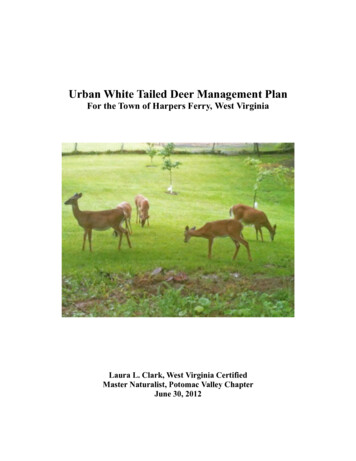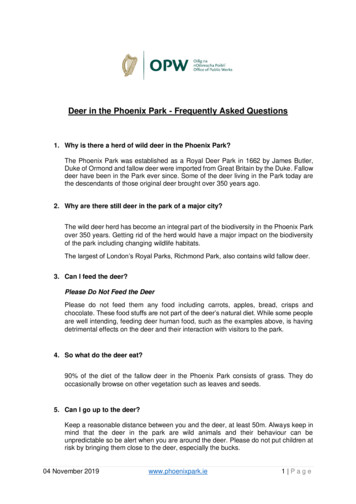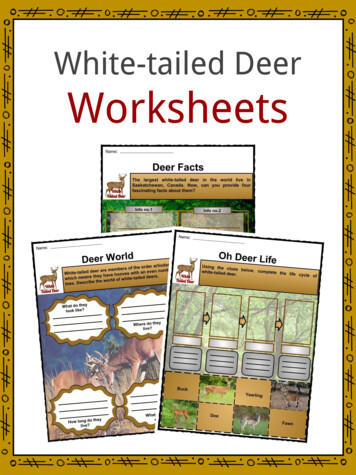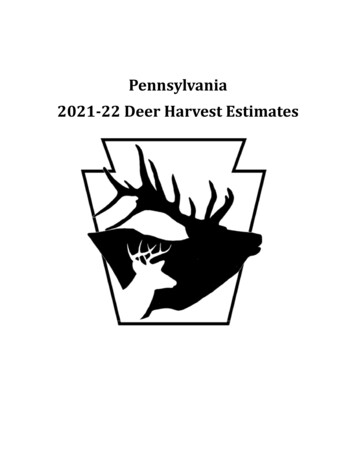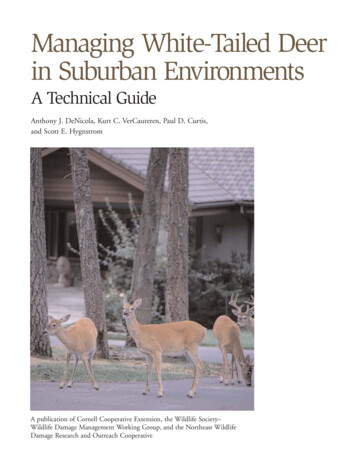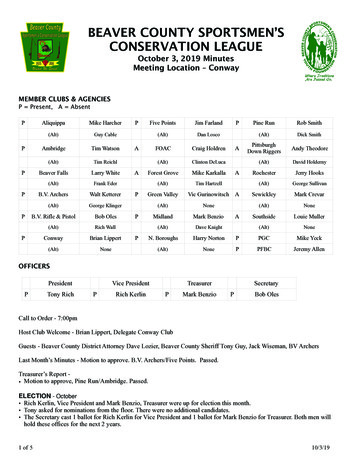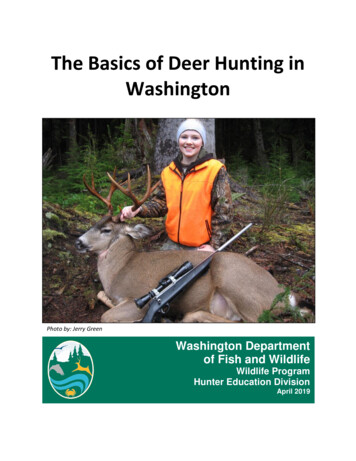
Transcription
South Carolina Species InformationDeerDeerPrepared by the National Wildlife Control Training Program. http://WildlifeControlTraining.comResearched based, certified wildlife control training programs to solve human – wildlife conflicts.Your source for training, animal handling and control methods, and wildlife species informationDepartment of Natural Resources and vary bygame zone. Specific rules and regulations canbe found online. http://dnr.sc.govWhere severe or persistent damage occurs,depredation permits may be issued to shootdeer at times other than legal hunting seasons.Request a permit from any South CarolinaDepartment of Natural Resources (SCDNR)Wildlife Management or Law Enforcement officeat no cost to the applicant. These permits arevalid for 30 days, and are renewable ifadditional time is needed to alleviate theproblem.Figure 1. White-tailed doe (Odocoileus virginianus).Photo by Greg Clements.Species OverviewFor further information: http://dnr.sc.gov.ConflictsDespite their economic and aesthetic values,white-tailed deer (Odocoileus virginianus) canconflict with a variety of human interests. Deercause damage to garden vegetables, fruit trees,flowerbeds, and ornamentals. They feed onagricultural crops, and when overabundant, cannegatively impact native plant communities.Deer threaten human health and safety by theirinvolvement in deer-vehicle collisions andtransmission of diseases, such as Lyme disease.Legal StatusIn South Carolina, deer are protected yearround, with the exception of legal harvestduring appropriate hunting seasons.Regulations are set by the South CarolinaNWCTP – South CarolinaThe popularity of deer as game animals and theneed to curb poaching have led to thedevelopment of severe penalties for illegalpossession. As a general rule, lethal control ofdeer cannot be initiated before consulting theSCDNR, which also may provide technicalassistance.IdentificationDeer are even-toed ungulates in the Cervidaefamily. White-tailed deer (Figure 1) are foundthroughout much of North America. Thevolume of literature on the ecology andmanagement of deer exceeds that for any otherspecies of wildlife. Biology and Management ofWhite-tailed Deer by Hewitt (2011) is anexcellent reference.Physical DescriptionAt birth, fawns are rust-colored with whitespots. The spotted coats are shed in 3 to 4months and are replaced by a grayish-brownState Species InformationPage 1
South Carolina Species InformationDeerwinter coat. The summer coat of an adult deeris reddish-brown. The area under the tail, belly,chin, and throat always are white.Antlers grow on males (bucks) from April toAugust. Development of antlers is nourished bya layer of soft, vascularized “velvet.” The driedvelvet is rubbed off and the antlers polishedduring the fall breeding season (rut). Size ofantlers depends on nutrition, age, and genetics.The antler tines of male white-tailed deer growfrom a central beam. The antlers are deciduousand shed in mid- to late winter.In South Carolina, a mature buck may weigh100 to 200 pounds. Does typically weigh 25% to40% less than bucks.Species RangeWhite-tailed deer are found in almost everystate in the US, except Alaska and Hawaii andare found throughout most of South Carolina.Health and Safety ConcernsDeer-vehicle strikes are the biggest threat tohuman safety that is posed by deer. In additionto the economic loss in damaged vehicles, 100to 200 people in the US die each year, alongwith thousands who are injured by hitting oravoiding deer (Figure 2). About 65% of the deervehicle collisions that occur annually happenduring the breeding season in October throughDecember. To reduce the chance and impact ofa deer-vehicle collision, drive cautiously, followthe speed limit, wear a seatbelt, observe deercrossing signs, and be extra vigilant during thefall breeding season and spring dispersal period.When you see one deer, anticipate that moredeer may be present.Figure 2. Deer-vehicle strikes constitute asignificant threat to human safety. Photo byunknown.Deer are susceptible to several diseases, butonly a few are of concern to humans. Deerassist in the movement and development ofticks that carry Lyme disease, ehrlichiosis, andbabesiosis. Deer can be reservoirs for bovinetuberculosis, which threatens the health oflivestock and humans. On rare occasions, deerhave attacked people.General Biology, Reproduction,and BehaviorReproductionWhite-tailed deer breed from October toJanuary, depending on latitude. Peak activity forbreeding is in November. Does are in heat for24 hours every 28 days for 2 or 3 consecutivecycles. One buck may inseminate several does,and no pair bonding takes place. Most doesbreed during their second fall, although in goodhabitat, up to 30% of doe fawns (6 months old)will breed. Gestation is about 202 days. Fawnsusually are born in May or June. Mostreproducing fawns give birth to a single fawn,but adult does typically bear twins.Bedding Cover (Loafing Areas)NWCTP – South CarolinaState Species InformationPage 2
South Carolina Species InformationBedding areas vary, depending on time of yearand location. Beds may be found in woodland,grassland, and agricultural fields.BehaviorDeer have a home range of several hundredacres that varies with season, sex, and habitatquality. Deer are crepuscular, which means theyare most active at dawn and dusk. Lifeexpectancy depends on factors such as huntingand nutrition. Deer can live for up to 20 years,although 10 years is above average in the wild.HabitatIdeal habitat for deer is the forest edge ratherthan dense, old-growth forest. They thrive inagricultural areas interspersed with woodlotsand riparian habitat. Deer favor earlysuccessional habitats where brush and saplingsare within reach (typically 6 feet tall or less).Populations of deer flourish in many urbanareas.Food HabitsDeer browse on leaves, stems, and buds ofwoody plants all year long. Forbs are eaten inspring and summer when available. Fruits andnuts, especially acorns, are seasonallyimportant. Agricultural crops such as corn,soybeans, grains, alfalfa, vegetables, and fruittrees are eaten readily.Voice, Sounds, Tracks, and SignsDeer may emit a warning snort when alarmedand bleat when in distress.Damage IdentificationDamage to LandscapesDeer damage a wide variety of ornamentals.Trees may be permanently disfigured bybrowsing or rubbing. High densities of deer mayseverely impact native plant communities andimpair regeneration of several tree species andNWCTP – South CarolinaDeerwildflowers. Deer are changing future forestcomposition in the Eastern US.Damage to Crops and LivestockDeer may cause damage to a wide variety ofrow and forage crops, vegetables, fruit trees,nursery stock, ornamentals, and stacked hay. Inaddition to the immediate loss of the crop,feeding by deer can affect future yields ofperennial plants such as alfalfa and fruit trees.Ornamental trees and nursery stock may bepermanently disfigured by browsing.Deer may compete with livestock for forages,both in the field and in storage. Deer areinvolved in the maintenance of diseases such asepizootic hemorrhagic disease and bluetonguein cattle.Damage to StructuresIn general, deer do not damage structures. Theyoccasionally run through and break fences andplate-glass windows.Damage Preventionand Control MethodsHabitat ModificationHarvest crops as early as possible to reducedamage by deer. Use deer-resistant ornamentalplants in home landscapes. In a few cases, lurecrops have diverted the interest of deer awayfrom valued resources.ExclusionProtect individual trees with woven-wire orplastic cylinders at least 6 feet high. Hightensile, woven-wire fences provide premiumprotection for orchards, nurseries, truck farms,backyards, and other valuable resources. Hightensile, multi-strand electric fences are a lowercost option for row crops, forages, livestock,and other farm facilities. Deer may learn how topenetrate electric fences, however, and fencesare less effective on large fields (10 or moreacres). Single-strand, baited polytape electricState Species InformationPage 3
South Carolina Species Informationfences are the lowest cost option for protectinggardens, small farm fields (less than 5 acres),and other areas from deer damage during thegrowing season.Frightening DevicesIn general, frightening devices are onlyminimally effective in protecting valuedresources from white-tailed deer. Deeracclimate quickly to noises and new features inthe environment, especially if they aremotivated by hunger. Thus, gas exploders,strobe lights, sirens, and scarecrows do notprovide reliable protection. The most effectivefrightening devices have been pyrotechnics,guard dogs, and deer-activated bioacousticdevices.RepellentsSeveral repellents are registered for use toprevent deer damage to plants, includingputrescent whole egg solids, ammonium soaps,thiram, capsaicin, garlic, and blood meal.Several home remedies, such as human hair andsoap, are reported to be effective, but researchdoes not support these claims. In general, theeffectiveness of repellents is highly variable anddependent on alternative resources, deerdensities, habituation, and motivation ofindividual deer. Repellents often must bereapplied after rain and to new growth.Fertility ControlReproduction in white-tailed deer can bealtered by immunocontraceptive agents andsurgical sterilization. Application of theseprocedures is limited due to expense,practicality, and regulatory issues. State permitsare required to treat deer, and then only bytrained professionals. Fertility control does littleto reduce densities of overabundant deerwithout other herd reduction efforts.ToxicantsNone registered for control of deer.NWCTP – South CarolinaDeerShootingShooting through regulated sport and managedhunting during the fall and winter can helpmaintain or reduce densities of deer.Depredation or nuisance permits may beavailable during non-hunting seasons to reducelocal densities and remove offending animals.Contact your nearest SCDNR field office fortechnical assistance and depredation permits.Sharpshooting is a specialized form ofpopulation reduction, typically conducted bytrained teams in urban and suburban areaswhere deer are overabundant. Theeffectiveness of shooting as a control method isdependent on access and vulnerability of deer,skill of the shooters, cost, and publicacceptance. Depredation permits may allowshooting of deer at night and the use of bait toattract animals to specific safe shooting sites.TrappingSeveral techniques are available for capturingdeer (e.g., cage traps, drop nets, cannon nets,net guns, and dart guns). All methods requireauthorization by the state wildlife agency. Eachmethod requires high levels of expertise and allare expensive to apply.DispositionRelocationLive capture and relocation of deer is notpermitted.TranslocationTranslocation of deer is not permitted.EuthanasiaThe most convenient method of euthanasia isshooting. For more information see theNational Wildlife Control Training Program.Web ResourcesState Species InformationPage 4
South Carolina Species ildlifecontrol.infoPrepared by the National Wildlife ControlTraining Program. WildlifeControlTraining.comCertified wildlife control training programs tosolve human – wildlife conflicts. The onlyresearch-based source for training, animalhandling and control methods, and wildlifespecies information.NWCTP – South CarolinaState Species InformationPage 5
Researched based, certified wildlife control training programs to solve human - wildlife conflicts. Your source for training, animal handling and control methods, and wildlife species information development of severe penalti. Figure 1. White-tailed doe (Odocoileus virginianus). Photo by Greg Clements. Species Overview . Conflicts
